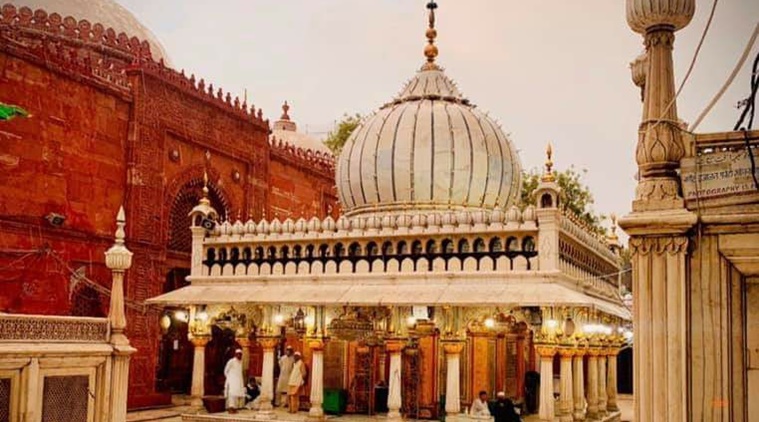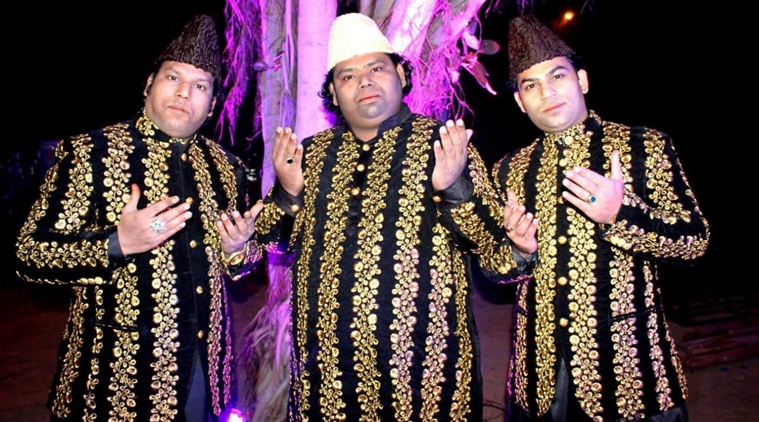 As the world struggles to cope with the pandemic, the urs is on hold, and the dargah is shut. (Source: Traditional Nizami Brothers)
As the world struggles to cope with the pandemic, the urs is on hold, and the dargah is shut. (Source: Traditional Nizami Brothers)
Around this time every year, the Hazrat Nizamuddin Auliya dargah is teeming with life for urs — the death anniversary of Hazrat Amir Khusrau, the 13th-century Sufi poet, mystic, musician, and the spiritual disciple of Nizamuddin Auliya. In life, the Sufi saint and his mureed were inseparable. In death, they rest close to each other: The tombs of the mehboob-e-elahi (friend of God) and the miftah-al sama (key of religious ecstasy) have stood for centuries as the manifestation of the core of Sufism — spiritual communion. To mark the urs every year, the mood at the dargah is celebratory. There is charaghan, when the whole premises is bathed in light, and lamps are lit up inside the tombs, too. Hundreds of thousands of people — of multiple religions and regions — congregate at the twin tombs for fateha (oblation/recitation) of holy verses, to offer platefuls of rose petals and sweets, and drape the fragrant chadars. Many sit on the floor and recite the verses from the Quran. The jaalis at both the tombs begin to resemble an art work as people tie their colourful threads of mannat (vows to the saints), each thread symbolising a wish — for a child, success, fame, happiness and healing. There is langar and scores are fed. Then, there is music. The strains of qawwalis — the high-pitched, soulful renditions of Khusrau’s Hindavi and Persian verses — ricochet through the shrine late into the night, as if the singers were attempting to strike up a conversation with the divine.
This year, however, as the world struggles to cope with the pandemic, the urs is on hold, and the dargah is shut. Khusrau’s 716th urs, derived from the Arabic word urus (wedding), also known as Satrahvin Sharif (Holy Seventeenth), will be a quiet affair. Held from June 9-13, the urs will see only silent prayers inside the mosque and the tombs, offered by a handful of the members of the dargah committee, says Syed Aziz Nizami, sajjada nashin (administrator), Hazrat Nizamuddin Auliya Dargah, underlining that it will be the first time in his memory that the dargah will see no celebrations during this time. The Nizamuddin basti has been de-sealed this week, 70 days after it was declared a hotspot, when several members of Tablighi Jamaat, who attended an event at the Markaz Mosque in mid-March, were diagnosed with COVID-19. “We are practising social distancing. This year, the urs will have no zayereen (visitors). Some of us will just sit and pray. The langar will be modest, and we will be delivering food to people’s homes,” says Nizami. The dargah is being sanistised every day, he says, even though it remains shut.
ALSO READ | The City of Mushairas
For those missing the urs this year, Rekhta’s Sufinama, in a bid to “keep alive the flame of this tradition,” will organise a virtual celebration of the urs on June 11, says founder Sanjiv Saraf, of the Rekhta Foundation. The celebrations, to begin on Rekhta’s Facebook page and Sufinama’s YouTube channel from 8 pm onwards, will begin with a talk on Khusrau by Akhlaq Ahan, professor of Persian at the Jawaharlal Nehru University, and former BBC producer Qurban Ali. There will be dastaans of Khusrau narrated by Syed Sahil Agha. And then there will be qawwalis by about 15 odd qawwals from across the country, who will perform live and pay their respects to the great Sufi saint.
Several popular qawwalis written by Khusrau will be sung. Shahid Niyazi qawwal of Rampur will begin the musical programme by performing Man kunto maula. Traditional Nizami Brothers from Delhi, who will perform during the virtual celebration, comprises three brothers — Jahanzeb Nizami (34), Alamzeb Nizami (32) and Ghulam Masood Nizami (30). Known for singing sehra, a form of qawwali, in Hansal Mehta’s 2017 film Omerta, these brothers have been singing the verses of several Sufi saints, like Rumi, Bulle Shah, Shah Hussain and Niyaz Beniyaz, but Khusrau’s verses have been special. Believed to be the direct descendants of the 12 young students handpicked by Khusrau to be a part of The Qawaal Bachcha who would be credited with inventing the form, the trio will perform Bahut din beete piya ko dekhe, in naqsh and gul, the two of the six styles of music — the other four being qaul, qalbana, tarana and khya — Khusrau is believed to have invented. Like most of performing artistes, these brothers have been staying at home for the last three months, doing riyaaz. “We are missing the urs so much. We belong there. Hazrat Nizamuddin, and Amir Khusrau, have given us an identity,” says Jahanzeb, who, like his brothers was trained in Hindustani classical music at an early age and learnt the nuances of qawwali by celebrated qawwals, Ustad Ghulam Sabir Nizami and Ustad Ghulam Waris Nizami, their uncle and father, respectively.
 Nizami Bandhu, who are not part of the Rekhta programme, but have participated in urs for several years, say this year, they will pray for the circumstances to improve soon. (Source: Traditional Nizami Brothers)
Nizami Bandhu, who are not part of the Rekhta programme, but have participated in urs for several years, say this year, they will pray for the circumstances to improve soon. (Source: Traditional Nizami Brothers)
Warsi Brothers from Hyderabad – Nazeer Ahmad Khan Warsi (53) and Naseer Ahmed Khan Warsi (50) – who have been singing qawwalis for nearly 35 years, will also perform during the online celebration. They say that while the world is at pause, the world of the Sufis can never end. “Even though we have been severely affected by the lockdown, with no income in months, we have to make do with whatever we have. That is what Sufism teaches us,” says Nazeer Khan Warsi. They say they have an “emotional attachment” with Nizamuddin and have attended the urs every year. “During urs, we only sing to Khusrau what he has taught us. As Sufi singers, the khanqah has been our playground. In the past, my forefathers left the jobs for kings and fell at the feet of the dervish,” he adds. Other virtual performers will include Raju Murli, the son of legendary Murli qawwal, Danish Hussain Badayuni, Affan Warsi and Shahid Niyazi.
Several other qawwals associated with Nizamuddin like Nizami Bandhu, who are not part of the Rekhta programme, but have participated in urs for several years, say this year, they will pray for the circumstances to improve soon. Akshay K R Sing, who manages Nizami Bandhu — comprising Chand Nizami (50), Shadab Nizami (40) and Sohrab Nizami (36) — says the brothers whose house is adjacent to the dargah, have been singing inside their homes, along with their joint families, and praying. “The life of these Sufi singers is another world. They are totally different — content and happy — even while they have not been performing that often,” says Akshay. For the rest, the distance from the dargah during this time is “only physical, not emotional.”
ALSO READ | Urdu and the young poets
Khusrau’s urs and the festivities around it are on the same scale as the urs of Hazrat Nizamuddin Auliya that precedes it by six months. Also called Satrahvin Sharif, the saint’s death anniversary is also an occasion for celebration. In most Sufi orders (called silsila) — be it Bukhari or Chishtiyya, Naqshbandiyya, Suhrawardiyya or Qadiriyya — death is not to be mourned, but celebrated. The saints are believed to be the lovers of god by the devotees, and their death means that they are ultimately united with their beloved.
During the urs in the time of pandemic, the admirers of Khusrau may perhaps read, sing and listen to his verses. Known as Tooti-e-Hindustan, (parrot of Hindustan), Khusrau’s contribution to the world of poetry and music remains unparalleled. His oeuvre consists of a staggering 92 odd books, including Laila Majnoon, Taj-ul-fatah, Tughlak Namah and Sheerin Khusrau. He straddled the twin worlds of both the dervishes and the kings, and served as a court poet under several rulers of the Delhi Sultanate during 1272 to 1325. He wrote poetry in several forms and languages, including Persian, Hindavi and Brij. He was a proponent of khayal and raag yemen and also invented sitar and dholak. Having been influenced by several cultures, including those of his Turkish father and his Rajput mother, Khusrau remains a symbol of India’s pluralistic and syncretic traditions.
Qawwalis were considered by the Sufis to be a stepping stone for transcendental experience. Qawwalis like Chhap tilak sab cheeni ray mosay naina milaikay (you’ve taken away my looks, my identity, by just a glance), which Khusrau wrote in praise of his spiritual guide, reflect his deep, undying love for the Sufi saint. Most of Khusrau’s kalaams are steeped in love and inclusivity, the tenets that are among his greatest legacy.
(After midnight, the programme will be available on Sufinama and Rekhta Facebook pages)